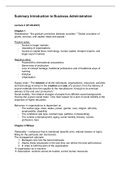Samenvatting
Summary + lecture aantekeningen Introduction to Business Administration
- Instelling
- Radboud Universiteit Nijmegen (RU)
samenvatting van het boek Organizational behaviour and work van Fiona M, Wilson. + aantekeningen van de gegeven lectures.
[Meer zien]





